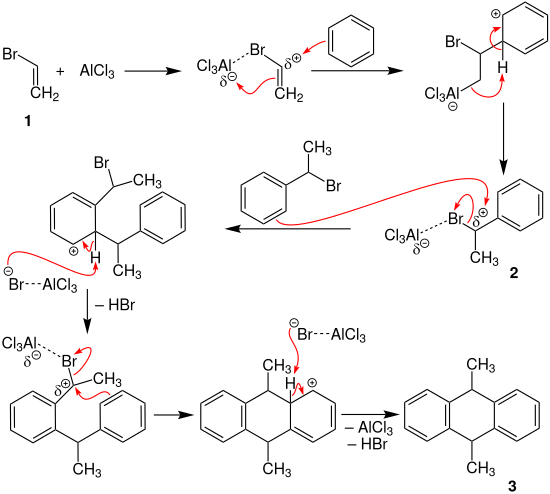Anschütz anthracene synthesis
The Anschütz anthracene synthesis , named after the German chemist Richard Anschütz , is a name reaction from the field of organic chemistry and was first described in 1884. The Anschütz- anthracene synthesis enables display of anthracene from vinyl bromide ( vinyl bromide ), and benzene by means of aluminum chloride .
Overview reaction
Benzene reacts with vinyl bromide under aluminum chloride catalysis to form 9,10-dimethyl-9,10-dihydroanthracenes:
The reaction can also be carried out with vinyl chloride ( chloroethene ).
Reaction mechanism
The following reaction mechanism is described in the literature and is similar to that of Friedel-Crafts alkylation :
In the first step, the Lewis acid aluminum chloride coordinates to the vinyl bromide ( 1 ) and ensures a partial positive charge on the carbon atom. With the loss of aromaticity , benzene undergoes an electrophilic attack. Subsequent rearomatization forms 1-bromoethylbenzene ( 2 ). A further molecule of 1-bromoethylbenzene then again leads to an electrophilic attack on the aromatic system, which finally results in 9,10-dimethyl-9,10-dihydroanthracene ( 3 ) with elimination of hydrogen bromide .
Individual evidence
- ↑ A. Angelbis and R. Anschütz: On the action of aluminum chloride on vinyl bromide in benzene and vinyl tribromide in benzene In: Ber. German Chem. Ges . 17, 1884, pp. 167-168, doi: 10.1002 / cber.18840170149 .
- ^ R. Anschütz: Contributions to the knowledge of the effect of aluminum chloride In: Justus Liebigs Ann. Chem. . 235, 1886, pp. 299-341, doi: 10.1002 / jlac.18862350305 .
- ↑ James M. Davidson and Alexander Lowy: REACTIONS OF VINYL CHLORIDE AND BENZENE IN THE PRESENCE OF ALUMINUM CHLORIDE In: J. Am. Chem. Soc. . 51, 1929, pp. 2978-2982, doi: 10.1021 / ja01385a015 .
- ^ Zerong Wang: Comprehensive Organic Name Reactions and Reagents , Wiley, 2009, ISBN 978-0-471-70450-8 , pp. 91-94.

